Is your sleep deep enough?
Jul 28, 2022
In a fast-paced world, getting enough deep sleep may seem like a luxury, but quality and quantity of sleep are equally vital – or body and mind suffer…
The sleep cycle
When we sleep, we cycle between different phases. Each is vital and a really good night’s rest includes five or six of each of these cycles. The first sleep cycle is about 1 ½ hours and each progressive cycle is slightly shorter:
- Non Rapid Eye Movement Phase (NREM) – where we first fall asleep, that floating, liminal space where we can easily reawaken.
- NREM 2 dropping a little deeper, heart rate and brain waves slow, eye movement stops and our temperature drops. About half of our time asleep is in this phase.
- NREM 3, deeper sleep, is characterised by longer, fuller breathing, Delta brain waves and an increase in Human Growth Hormone. This is where we strengthen immunity and body and brain repair. If we are woken from this stage, we feel groggy and disorientated.
- Rapid Eye Movement (REM), the stage in which we dream. A lighter stage of sleep more like drowsy wakefulness
The spiral of sleep deprivation
We all know how it feels when we don’t get enough decent sleep, but what’s going on chemically that causes this? Detoxification, tissue and muscle healing and emotional processing all occur as we sleep deeply. If this essential downtime isn’t respected, we may quickly see symptoms like fatigue, irritability, erratic concentration, headaches and migraines, and poor recovery from stress – and so we become more susceptible to viruses, inflammation, injury and skin complaints.
During deep or ‘Delta’ sleep, the slowest brain wave state, critical processes occur in our brains which effect memory, cognitive processing and aging. Our brain and central nervous system (CNS) are cleansed of toxins by the glymphatic system. The hormone melatonin (a hormone produced in the brain in response to lack of light) can cross the blood-brain barrier so is essential for clearing neurotoxins that can cause neurological damage and even Alzheimer’s, when the brain produces dysfunctional proteins that are not sufficiently synthesised.
Lack of sleep, even at a small, accumulative level can lead to craving sugar, calorie-rich foods and stimulants as our bodies try to fuel up in the face of less vitally built-up energy, associated with weight gain. Inadequate sleep, because it negatively effects our detoxification process, can also lead to inflammation in the digestive system and associated disorders.
Sleeplessness is also responsible for a depletion in our sex drive, responses, and activity – where we become more challenged because of lack of deep rest, we are more likely to become caught in cycles of adrenal overload and when we are in fight or flight, we do not have space to procreate. The feel-good chemicals released during love-making are conducive to deeper rest.
Preparing for deep sleep
Research has shown that it is not simply quantity, but quality of sleep that counts. It is possible to feel more rested and wake up more refreshed with some simple solutions.
- Reduce stimulation Reducing time on screens in the two hours before bed improves the quality of our sleep, helps increase melatonin levels, attune to our body’s natural Circadian rhythms, and optimizes heart rate variability. Also what we consume is important: we can tend to ‘do’ rather than ‘undo’ in the late evening, often with a fear of coming down from stimulation of an addictive box set and constant noise of the day. We can nourish a calm ‘alpha’ brain state ready for bed by reading non-thrilling books or listening to soothing music.
- Make time for bed Allowing enough time to prepare for sleep readies body and brain for deeper rest. Finding a relaxing, regular pre-bed routine – perhaps some restorative yoga or meditation, a bath with essential oils – creates positive signalling; “I am ready to sleep”. Consistency is key: regular bedtimes and length of sleep optimise sleep patterns best, allowing us to tune in to our natural cycles. Research has linked variable sleep-wake cycles to an increase in risk of insulin-resistance, type 2 diabetes and obesity.
- Clear difficult energy If we are holding on to stress, the mind is too busy, it can be harder to get to nod off and sleep deeply. Kissing and making up with our partners if we have argued, allows us not to take unresolved issues into our dreams. If we are holding ‘to do’ lists or trying to process a lot in our heads before bed, writing it down or talking into our phones – stream of consciousness is fine, this doesn’t have to be edited, just physically taken out of our heads – can create a healthy boundary between the day and night. Journaling can be a soothing practise that allows us to consciously observe our mental states and habits – accepting that our brains may be on ‘constant alert’ from daytime stress we can realistically enquire on reflection if there is really anything that can be done to resolve the problem at that time. Rather than gnaw at things that cannot be changed, release them onto paper or record them so there is no need to hold on to them.
- Feed healthy sleep Having three regular meals throughout the day, including protein at each – meat, fish, eggs, nuts, beans or goat’s cheese – helps produce sleep hormones and regulate energy to not rely on the sugar or caffeine that can keep us awake later.
If you tend to wake during the night, have a bedtime snack – slow-release carbohydrate foods like apples or oatcakes help prevent night blood sugar crashes that cause a stimulating adrenaline surge. A few stalks of celery before bed can calm the nervous system – a potent traditional sleep remedy. - Move more, sleep better During the day, regular movement practises (ideally mixing cardiovascular, weight-bearing and resistance with low-impact disciplines such as yoga, Tai Chi or Qigong) improve circulation, stimulate lymphatic drainage, improve tissue oxygenation, mood, clarity and cognitive skills as well as reducing stress; all of which conduce to better sleep. Before bed, a restorative, restful asana practise (see below) can help us to relieve held muscular and soft tissue tension so that we are physically prepared to ‘let go’. We can use a softer, stiller practise to bridge the gap between the doing of the day and the inactivity of the night, both physically and mentally.
- Calm your nervous system Regular meditation practise has been shown to help reduce chronic stress and many associated disorders that impede deep sleep, from snoring and sleep apnea to bruxism (tooth grinding), restless leg syndrome and insomnia.
See https://www.charlottewattshealth.com/online-zoom-classes-with-charlotte for meditation classes/recordings.
Yoga nidra is another meditative practise that can both focus and attune the mind as well as dropping us into a deeply relaxed state. A 2002 study[1] showed that Yoga nidra practise increased dopamine levels, which both improves concentration and sleep.
Within a 20-minute yoga nidra practise: “people can cycle through the whole set of brain waves we cycle through at night.”[2]
See https://www.charlottewattshealth.com/online-zoom-classes-with-charlotte for yoga nidra classes/recordings.
- Be more touchy feely Self or shared massage can also be incorporated into our sleep routine, either as part of our restorative asana practise or of its own right. Light, soothing touch can release feel-good hormones serotonin, dopamine and oxytocin and decrease stress hormone cortisol, as well as reducing blood pressure, anxiety and depression, so improving deep sleep.
See https://www.charlottewattshealth.com/online-zoom-classes-with-charlotte for self-massage classes/recordings.
- Breathe easy Encouraging deep, fluid, nasal breathing is hugely beneficial to the whole, but has real impact on sleep too. Our parasympathetic – or rest, digest and heal – nervous system is activated by nasal breathing. When we breathe nasally, our breathing rate slows, we increase nitric oxide levels, immune function is improved, we have better oral health and lubrication (no waking with a dry mouth) and the quality of our deep sleep is improved. A regular conscious breathing practise can improve our awareness of patterns and allow us to form more healthy breathing habits. (See below for practise)
- Draw inwards Ear plugs and blackout blinds or heavy curtains/eye masks create a more peaceful environment where we can naturally draw inwards, distracted less by the external world. Dark bedrooms create better sleep as the pineal gland only produces the sleep hormone melatonin when it senses low light levels. Remove electronic devices and cover any lights to reduce stimulation.
Keep the bed for sleeping in only (and making love). Create a safe, cosy haven for sleep - make sure the bedroom is quiet and restful and enjoy fresh clean sheets. Keep this space free from clutter and mess to encourage a clear, calm mind.
Simple Evening Restorative Yoga Practise:
You can creatively flow through this whole sequence or simply choose one or two postures to deeply settle the nervous system in preparation for meditation, yoga nidra or directly to sleep, depending on your time.
Constructive Rest Position (CRP)
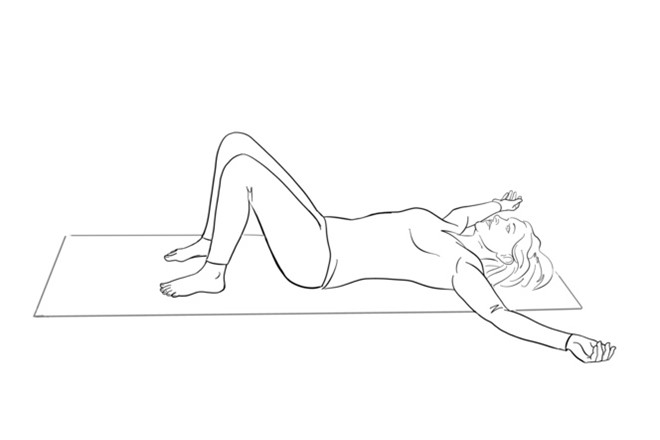
- Start with a neatly folded towel or blanket under your skull so that there is a softness in the throat and at the root of your tongue. Feet about hip-width apart, not too close to the bottom, so that it is easeful, the back muscles passive. If there is any pinching at the lumbar or the feet, or it feels that the legs are dropping out, turn the feet inwards and drop the knees together for support. Arms are out to the side, elbows bent to whatever degree allows them to soften and release.
- Notice the jaw and the temples. Lightly tuck the chin in towards the throat, as this can ease the passage of breath. Move the lower jaw gently to release, attending to any tension around the skull with gentle rolling of the head, side to side. Invite an ‘aah’ sound with the exhalation, creating space between the back of the teeth, feeling the vibration around the jaw and throat.
- Peacefulness in the nervous system is represented by softness of the inhale through the nose. Try not to ‘do’ or ‘fix’, but rather simply notice the body as it is, without adjustment. In this way, sensing the difference between left and right, top and bottom body and where the body meets the ground. Notice the very real physical movement of the breath in the body.
- Softly position the hands on the abdomen. Tune in to the rise on the inhalation. The fall on the exhalation. This positions the psoas neutrally so we can better notice breath into the belly.
- Slide the hands up to the diaphragm, feeling the easeful movement of the lungs and ribs – tidal rhythm, each breath unique.
- CRP is a reset for our natural spinal curves and a place to allow space and cultivate internal awareness of unconscious, habitual instincts.
- After 10-15 minutes observing the breath, move the jaw and face, wriggle the shoulders and take the arms out to the side at shoulder height.
- Exhale the head to roll it to one side, without pushing or forcing. Inhale it back to centre and exhale to the left. As the neck softens, as the head turns to one side, reach the opposite arm out from the centre to make space in that shoulder. Inhale back to centre and move that side-to-side.
Viparita Karani
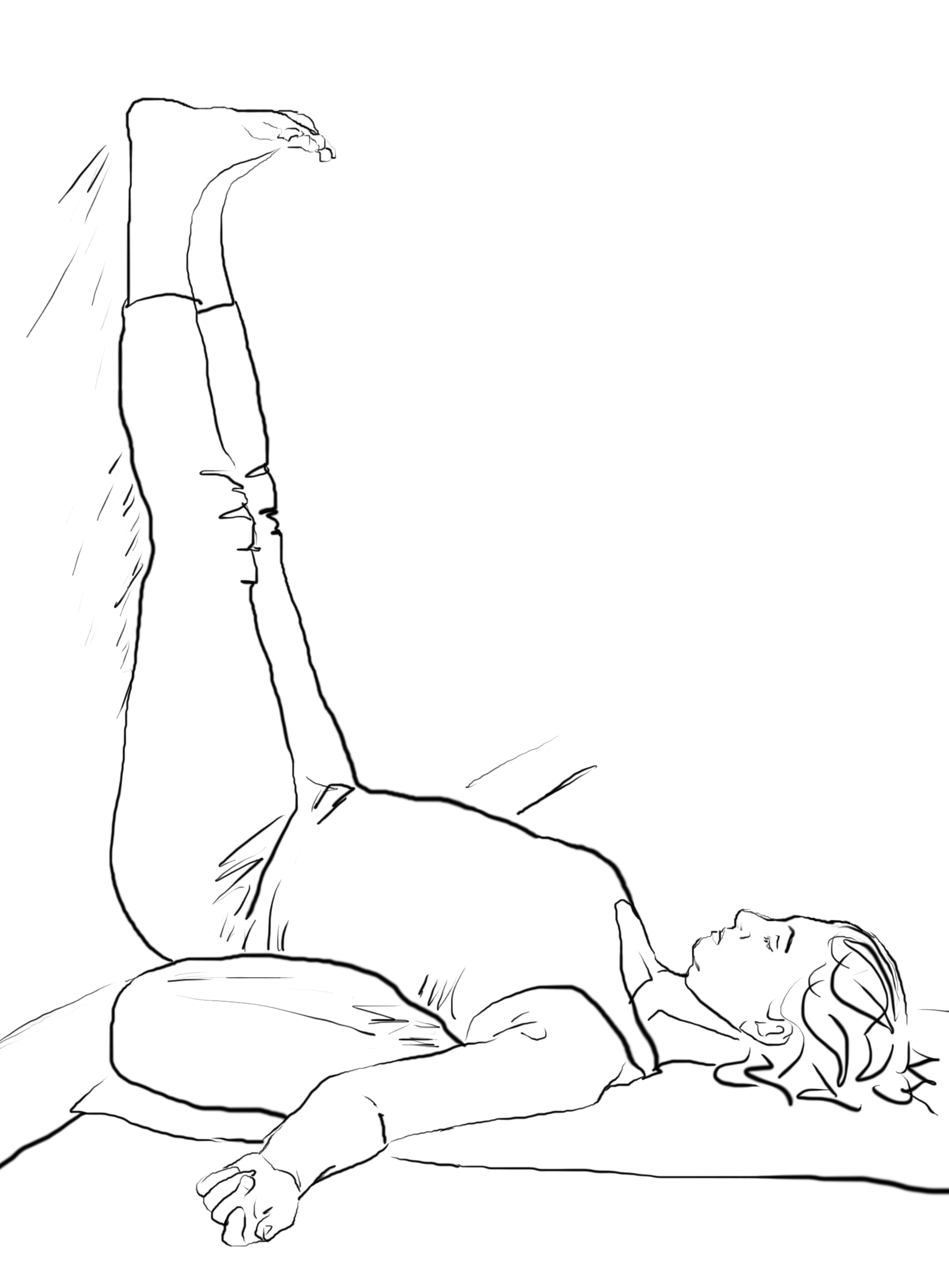
Lie with your legs up the wall, with your feet together and the back of your pelvis supported by a bolster or cushion that allows you to be free from the waist up. Hold your arms two feet away from your body, palms up and breathe calmly though your nose for 5 minutes, focussing on lifting the heart and keeping the jaw, throat and face soft to calm the nervous system.
Apanasana with hug
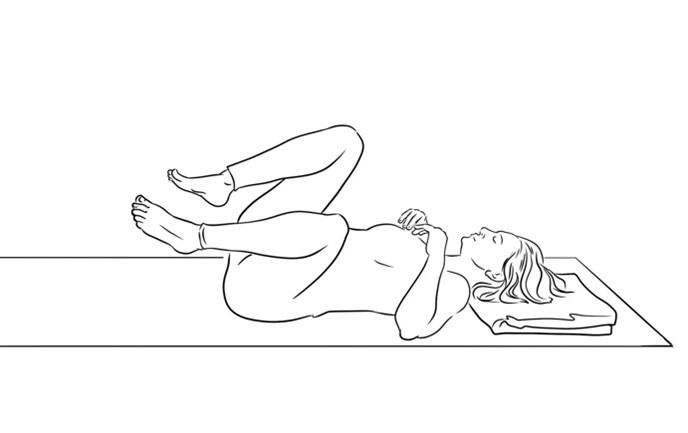
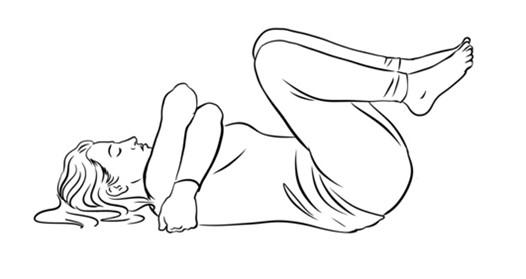
- Draw each leg into and away from the chest, exploring and feeling what is in the lower body before drawing in towards Apanasana.
- Reaching the arms right around the opposite shoulder and settling into a protective, nurturing position around the heart. This calms, stimulating oxytocin release. Our proprioceptive senses are stimulated around the torso by the arm bind.
- Repeat with the arms in the opposite cross of the hug. Notice the response of the breath and the nervous system.
Adrenal Response Sequence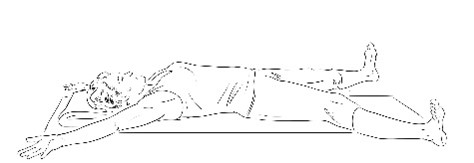
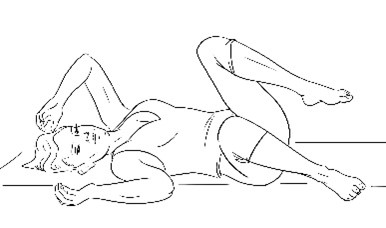
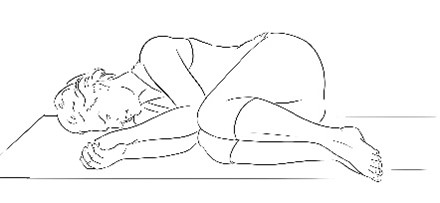

This sequence is ideal when reactivity is part of sleep issues. If possible, do regularly around the same time every day, for instance on returning from work or before bed. These are transitional times where we may struggle to adapt; numbing with sugar or alcohol later in the day or avoiding sleep because we are highly strung or expectant of sleep difficulties.
- Open up into a star shape on the ground, reaching out through fingers and toes as is comfortable.
- Expanding through the front body on the inhale, on the exhale curling onto one side to come right into a foetal position. Re-opening all the way back out to centre, meeting the world with the inhale. Exhale back over onto the other side. Following this pattern side to side, noticing the shift between the protective foetal curling and the reaching out to occupy your whole self in this large body print.
- The next time you come into a foetal position on one side, holding that there, to protect the belly and heart, breathing into the back of the lungs, back of the ribs and lower back.
- Rolling up easefully from the side and resuming the foetal position in an upright plane, soothing the parasympathetic system, curling inwards in a gesture of restoration and healing.
Focussed Breathing Practise
Lay or sit in a fully supported position with eyes closed. Release the jaw, forehead and eyes. Begin counting ‘one’ on the inhalation, ‘one’ on the exhalation. Continue counting the full breath cycle like this up to ten and then start again. If your mind wanders or you lose count, simply start again at one. There is no judgement (you can count to 10!) You can also use this technique if you wake during the night.
For a guided journey into deeper, more restful sleep why not try our Yoga Nidra classes? Full details can be found here.
Sweet Dreams!
Discover Whole Health with Charlotte here, featuring access to yoga classes, meditations, natural health webinars and more...
[1] https://pubmed.ncbi.nlm.nih.gov/11958969/
[2] Yoga Nidra Made Easy, Uma Dinsmore-Tuli & Nirulipta Tuli, www.yoganidranetwork.org




